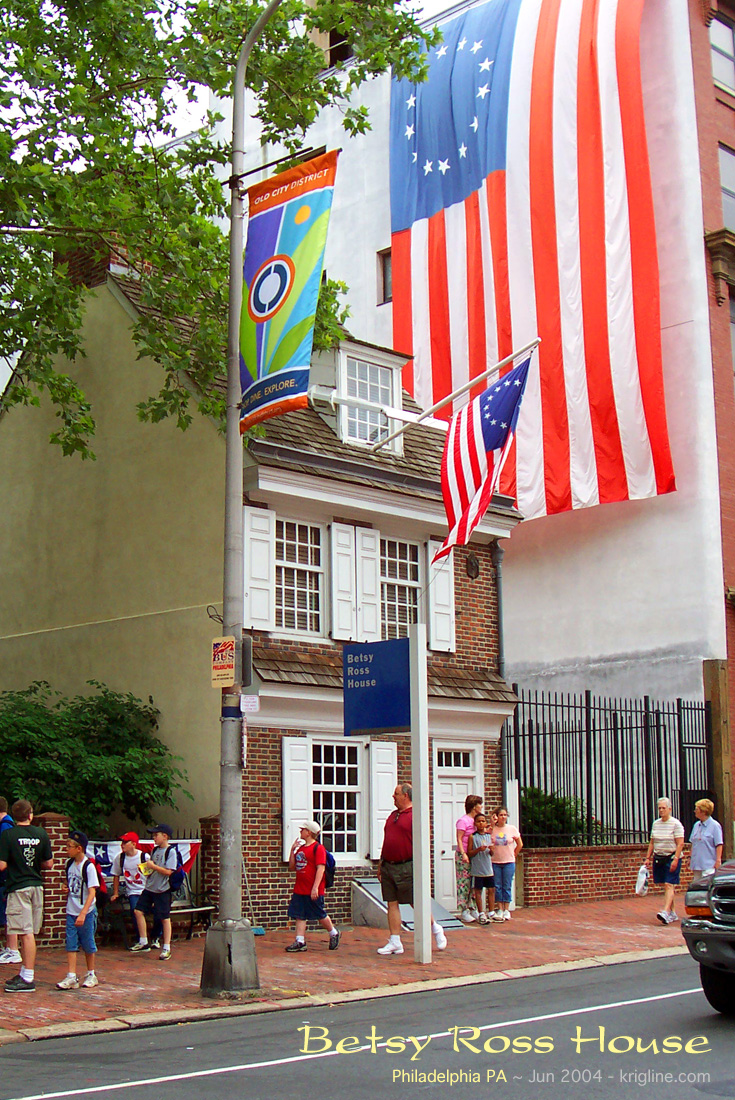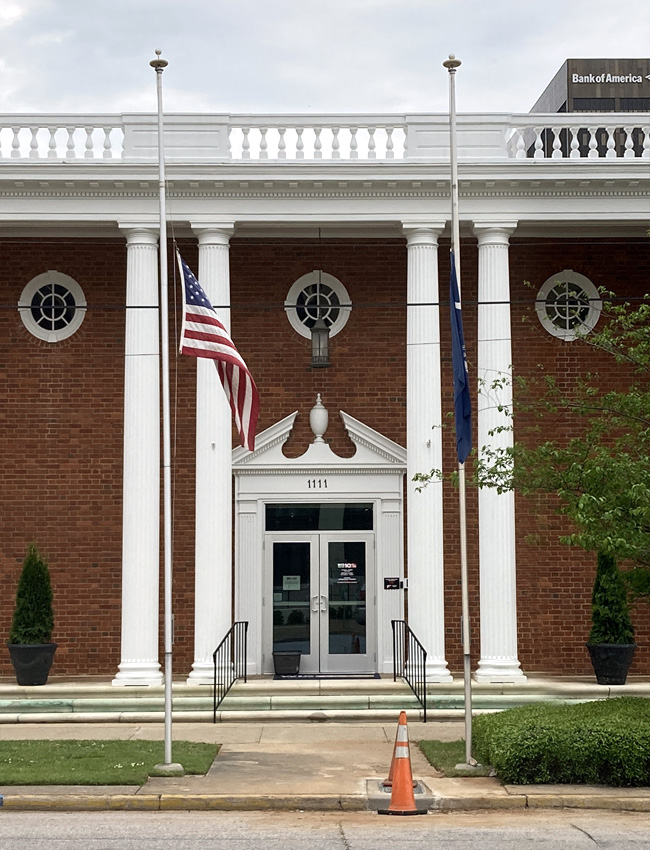Flag Day
June 14 is Flag Day in the US; plus an explanation of “half-staff” flags.
Jun 13, 2020. wp.krigline.com ⇔ (for a version using lower-level English, click here)
Why are there so many flags on June 14?
Many Americans proudly display the US flag in front of their home or business every day, and you’ll also find the flag outside or atop government buildings, but if you were to visit the US on June 14, you might wonder why so many people are flying the flag.
June 14 is called “Flag Day,” commemorating the adoption of the official flag on June 14, 1777. (The American colonies declared their independence from Great Britain on July 4, 1776, so that date is celebrated as the nation’s birthday.) Flag Day is not a “holiday” in which people get a day off from work; it’s just a day of commemoration. The origins of the holiday are fuzzy, perhaps dating back to the 1860s (during the American Civil War). President Woodrow Wilson first proclaimed June 14 as national Flag Day in 1916. Pennsylvania was the first state to make Flag Day a legal holiday (1937). Congress established National Flag Day in 1949 (the act was signed by President Harry Truman), though technically it is at the current president’s discretion to officially proclaim the observance. Incidentally, about a year after his Flag Day proclamation, Pres. Wilson asked Congress to declare war on Germany (World War I). He was also President during the 1918 “Spanish flu,” which devastated the world like COVID-19; many believe Pres. Wilson himself even contracted the flu, while in Paris to negotiate the end of WWI (in 2019). He was a busy guy!

Betsy Ross House in Philadelphia. A nearby historical marker says, “As a skilled artisan, Ross represents the many women who supported their families during the Revolution and early Republic.” [I graduated from Eastern University, outside Philadelphia.]
Who was Betsy Ross?
Betsy Ross, one of America’s most famous “founding mothers,” was a seamstress who lived and died not far from Philadelphia’s Independence Hall, where the 1776 Fourth of July Declaration of Independence was signed by the Continental Congress. Ross was a single mom, having been widowed twice by age 30. General George Washington (later the first US President) knew Mrs. Ross from Christ Church, which both sometimes attended. He and other Founders asked Betsy to make the first flag, adding that they would need many copies soon. According to Dr. Lillback, Washington asked for six-pointed stars, but Betsy convinced the Founders that a five-pointed star would be easier to cut and sew, and thus save them a lot of time and money. According to tradition, Ross sewed the first American flag, and then kept making them for more than 50 years.
The US Flag at half staff
Sometimes students ask why the US flag is only half-way up the flag pole. You often see the United States flag flying at “half-staff” (or half-mast) when the nation or a state officially marks the death of someone important, such as a government official, military member, or first responder. Flags also fly at half-staff on Memorial Day, other national days of remembrance, or following a national tragedy. Many countries have a similar practice.
You’ll see this most often at places owned by the government, where someone is paid to take care of the flags. In fact, people can ask their senator or representative to send them a flag flown over the US capital building on a certain date (such as the person’s birthday); there is a cost involved (see https://www.aoc.gov/flags for info). I have such a flag, flown on my 18th birthday (thanks, Mom and Dad!). According to the “Architect of the Capitol” website, they fulfill 100,000 flag requests from Members of Congress annually.
Often, we don’t know why the flag is half-staff; it depends on how important the occasion is to the media. So, I found the following widget. If it works, below you will see why the flag is half-staff today (if applicable).
(Must have Javasript installed to see this image. Source: https://halfstaff.org/widget/)
Vocabulary:
- to adopt (adoption): to formally accept sth in a permanent way (e.g., adopting a child, or celebrating a foreign holiday)
- commemorate: to honor or remember an event or contribution. Note: English-learners sometimes confuse the terms commemorate/memorialize/memorial/memorize. You remember or honor people, and they can be memorialized (a passive verb) for their contribution or example. We can also remember our loved ones at a memorial service after they have passed away. People sometimes build a memorial or monument to pay tribute to or honor (or memorialize/commemorate) a person or event. Memorize means to put something into your memory (e.g., to learn a poem by heart).
- constellation: a group of stars that forms a pattern and has been given a name (e.g., “the big dipper”)
- first responder: a police officer, fire-fighter, emergency medical personnel, etc., who might be the first person to answer a 911 (emergency) call to help others
- fuzzy: (adj) unclear, confused; literally describes the hairy way a kitten feels, but figuratively can describe an unclear picture, memory, etc.
- reprimand: to express your strong official disapproval; to criticize in front of others
- seamstress: someone who sews or repairs clothing or similar things (curtains, flags…); a tailor
- staff: the pole (e.g., from which a flag flies)
- tattered: appearing old, torn and worn; ragged
- technically: according to specific rules (such as grammar rules or legal codes); in a strict sense
- valor: great courage, esp. in war
- vigilance: careful attention to details in order to avoid problems or to notice them as soon as they appear (a soldier on guard duty must have vigilance at all times)
- widget: software used on a web-page to give the visitor a box with changing/temporary information; any small device you’ve forgotten the name of
Discussion:
Content questions:
- In the US, which day is normally Flag Day?
- Why was that date chosen?
- Which US President first proclaimed Flag Day (in 1916)?
- In what year did Congress establish National Flag Day?
- Where was Pres Wilson when he caught “the Spanish flu” during the 1918 pandemic?
- What job did Betsy Ross have? (Why is she famous?)
Broader questions:
- According to the article, what do the three colors in America’s flag stand for? Please tell your classmates about your country’s flag (what picture is on it? what do the colors stand for? etc).
- Look at the photo of the large flag outside Betsy Ross’ house. How is it different from a modern US flag? Can you explain the difference?
- In your country, where do people see the nation’s flag? Do individuals display a flag outside their home? Inside a church? At schools? Do you think there are too many flags in public, too few flags, or “just enough”? Explain.
- Betsy Ross is one of America’s “Founding Mothers”. Tell us about a famous woman in your country’s early history.
- Look at the definition for “commemorate” again, and create a sentence with each of these words: commemorate, memorialize, memorial, memorize.
- In America, sometimes the US flag is only half-way up the flag pole. This normally marks someone’s death or a national tragedy. Do you have a similar practice in your country? Are flags used or flown in other ways?
- Why do you think every country has a national flag? What are the good things about having a national symbol like this? Are there any negative aspects to such symbols?
- If you still have time, talk about other popular “national symbols” in the US or in your country. (Examples might include a famous bridge or building, “the Statue of Liberty” in New York, etc.)
Information sources include https://en.wikipedia.org/wiki/Flag_Day_(United_States) & https://en.wikipedia.org/wiki/Flags_of_the_U.S._states_and_territories (June 13, 2020), flaghttps://www.publicdomainpictures.net.jpg, https://www1.cbn.com/cbnnews/us/2020/june/on-flag-day-remembering-the-woman-who-sewed-old-glory-into-existence, and https://www.aoc.gov/flags.
EFLsuccess.com; ©Michael Krigline, all rights reserved. This resource was created for our students under my understanding of “fair use” for educational resources. As far as I am concerned, people are allowed to print/copy it for personal or classroom use. See our Website Standards and Use Policy.
~ ~ ~ ~ ~ ~ advertisement ~ ~ ~ ~ ~ ~


